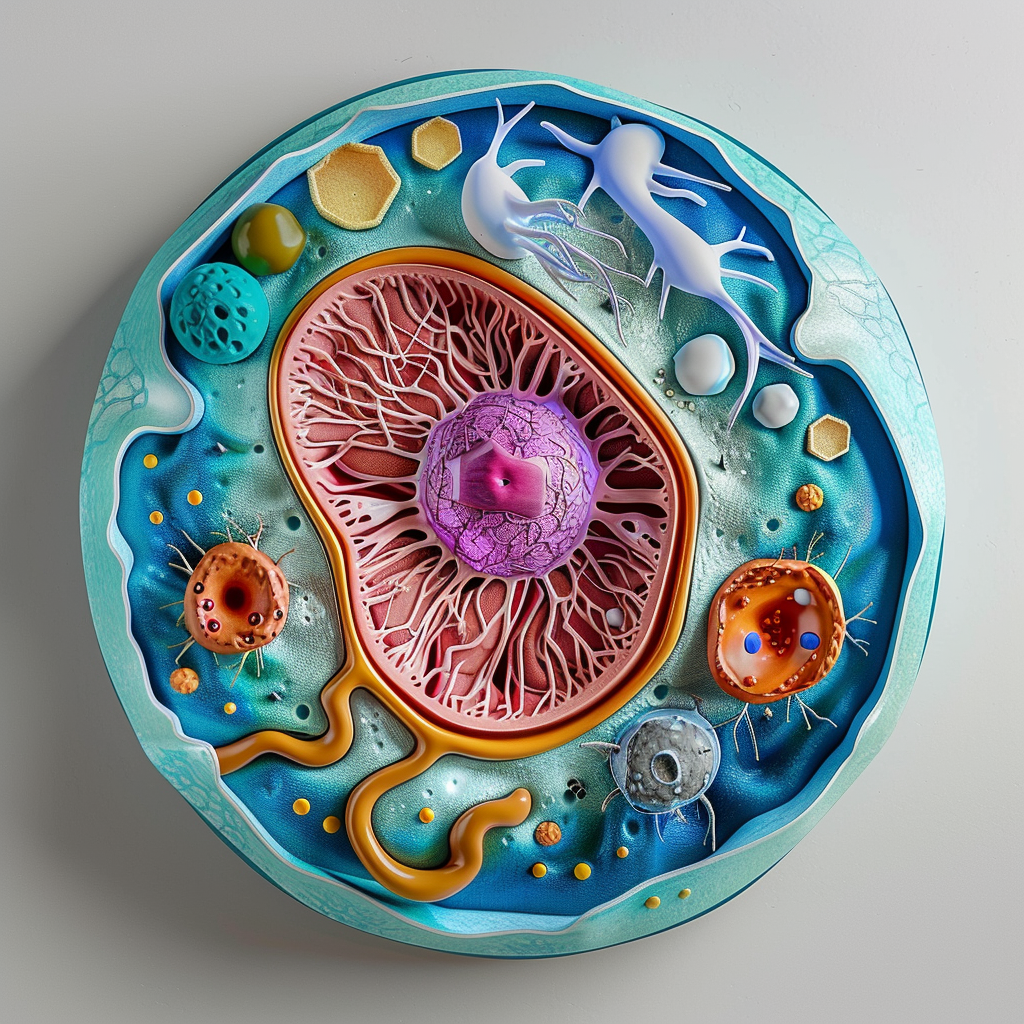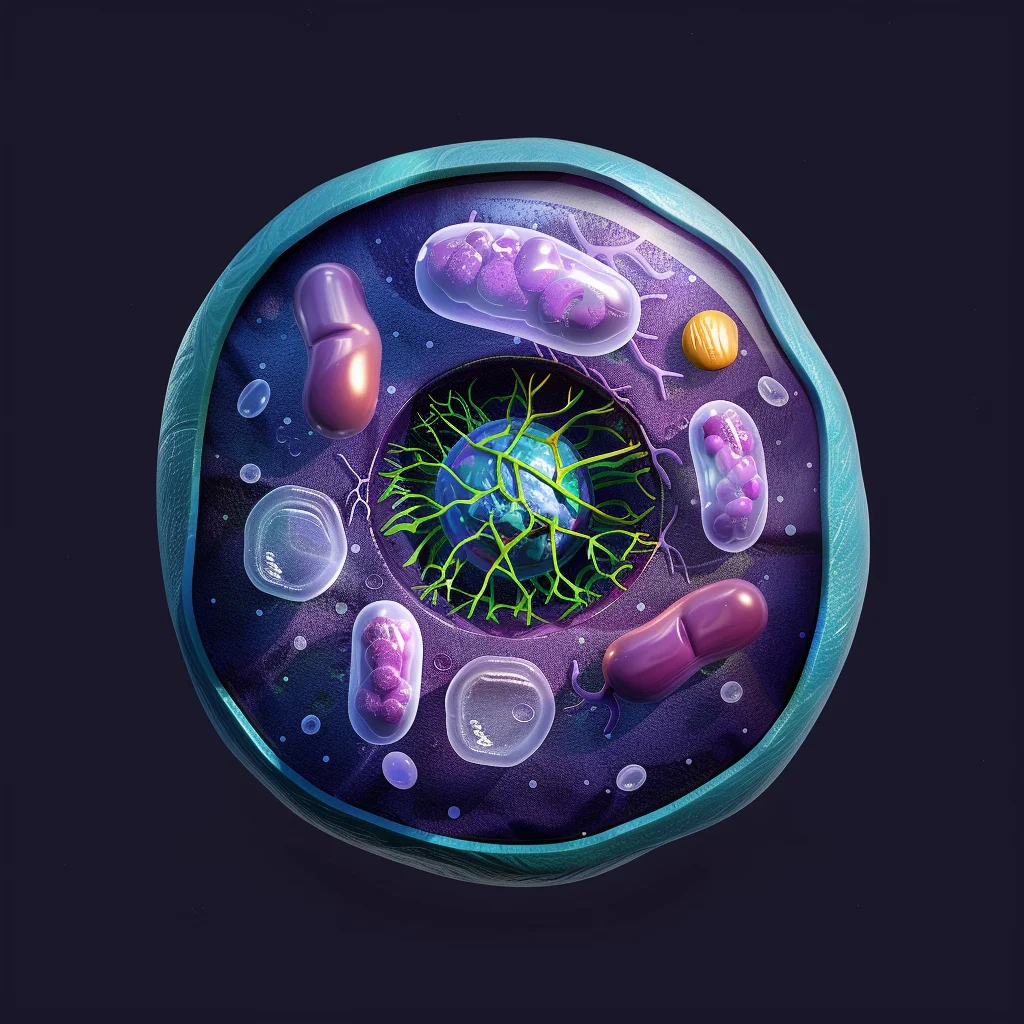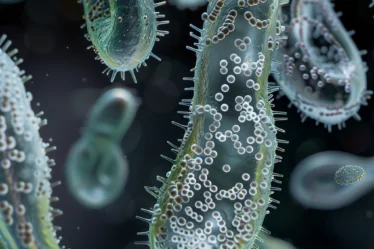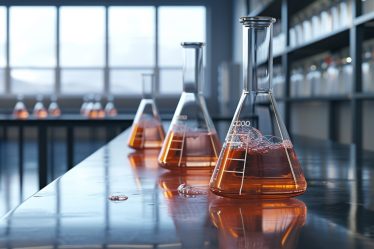
Eukaryotes are organisms with cells with a nucleus and organelles enclosed within membranes. This group includes animals, plants, fungi, and many single-celled organisms.
Eukaryotic cells are more complex and larger than prokaryotic cells, which lack a nucleus. Prokaryotes, like bacteria, are simpler and usually smaller. Eukaryotes are vital because their complex cell structure allows for diverse forms and functions, enabling the development of complex life.
This guide will help you understand eukaryotic cells’ structure, evolution, diversity, and how they differ from prokaryotic cells.
Essentials of Eukaryotes and Eukaryotic Cells
Are you short on time? Here are the must-know aspects of eukaryotes, eukaryotic cells, and the difference between eukaryotes and prokaryotes:
🟠 Eukaryotic cells have a nucleus and organelles, enabling complex structures and functions in organisms.
🟠 Eukaryotes evolved through symbiogenesis, with ancient cells merging to form more complex structures like mitochondria.
🟠 Eukaryotic cells reproduce through mitosis and meiosis, allowing for genetic diversity and adaptability.
🟠 Eukaryotes show various forms and functions, including unicellular and multicellular organisms such as protists, animals, plants, and fungi.
🟠 Eukaryotic cells are larger and more complex than prokaryotic cells, with distinct structural and functional differences.
Do you need help with prokaryotic and eukaryotic cell? That’s okay! Personalized tutoring or interactive biology classes can help you understand these topics better. Explore more biology topics and expand your knowledge with our free Biology blogs.
Eukaryotic Cell Structure
Eukaryotic cells are complex and contain various organelles that perform specific functions. These organelles, surrounded by membranes, help the cell manage different activities efficiently. This section covers key organelles and the cytoskeleton, which supports cell shape and movement.
Membrane-Bound Organelles in Eukaryotes
Eukaryotic cells have several membrane-bound organelles, each with distinct roles.
Nucleus
The nucleus is the cell’s control center. It holds DNA and directs activities like growth and reproduction. The nuclear envelope surrounds the nucleus and protects the genetic material. Inside, the nucleolus begins ribosome assembly, while chromosomes made of DNA and proteins store the cell’s genetic information.
Mitochondria
Mitochondria are the cell’s powerhouses. They generate energy by converting glucose and oxygen into ATP, which fuels the cell’s activities. Mitochondria have their DNA and reproduce independently within the cell.
Endoplasmic Reticulum
The endoplasmic reticulum (ER) has two types:
Rough ER is covered with ribosomes and synthesizes proteins, which are transported to other cell parts or exported.
Smooth ER produces lipids and detoxifies chemicals, playing a role in hormone synthesis and breaking down toxins. It also stores ions in muscle cells and helps regulate metabolism.
Golgi Apparatus
The Golgi apparatus processes, sorts, and packages proteins and lipids for transport. It receives molecules from the ER, modifies them, and sends them to their destinations. The Golgi apparatus is essential for producing cellular products like hormones and enzymes.
Lysosomes
Lysosomes contain digestive enzymes that break down waste materials and cellular debris. They digest unwanted substances and recycle cellular components, keeping the cell clean and healthy.
Vacuoles
Vacuoles are storage sacs within the cell. Plant cells have a large central vacuole that stores water, maintains cell pressure, and supports the plant’s structure. Animal cells have smaller vacuoles that store nutrients, waste products, and other substances.
Chloroplasts (in plant cells)
Chloroplasts in plant cells and some protists contain chlorophyll and carry out photosynthesis, converting sunlight into chemical energy stored in glucose. Like mitochondria, chloroplasts have their DNA and reproduce independently within the cell.
Peroxisomes
Peroxisomes contain enzymes that break down fatty acids and amino acids. They detoxify harmful substances like hydrogen peroxide by converting them into safer molecules.
Cytoskeleton and Eukaryotic Cell Shape
The cytoskeleton provides structural support for eukaryotic cells, maintaining their shape and enabling movement. It has three main components: microtubules, actin filaments, and intermediate filaments.
Microtubules
Microtubules are thick, hollow tubes that move organelles and chromosomes during cell division. They form spindle fibers that separate chromosomes during mitosis and create tracks for the movement of vesicles and organelles within the cell.
Actin Filaments
Actin filaments, or microfilaments, are thin strands involved in cell movement and shape changes. They play a crucial role in muscle contraction, cell division, and cell signaling. Actin filaments also support the cell membrane and help the cell maintain its shape.
Intermediate Filaments
Intermediate filaments provide strength, helping the cell withstand stress. They stabilize the cell’s structure and hold organelles in place. Compared to microtubules and actin filaments, intermediate filaments are more permanent structures, providing long-term stability to the cell.
Centrosomes and Centrioles
Centrosomes are organelles that serve as animal cells’ main microtubule organizing centers. Each centrosome contains a pair of centrioles, which help organize microtubules during cell division. Centrosomes form the spindle fibers that separate chromosomes during mitosis.
Cilia and Flagella
Cilia and flagella are hair-like structures that extend from the cell surface and aid in movement. Cilia are short and numerous, moving fluid and substances across the cell surface. Flagella are longer and fewer, propelling the cell through its environment. Both structures are made of microtubules arranged in a specific pattern.
Together, these elements form a dynamic framework that supports the cell, aids in intracellular transport, and enables activities like cell division and movement.
Are you curious about evolution? Darwin’s theory of natural selection explains how species evolve based on traits that help them survive and reproduce.
Evolution of Eukaryotes
With their complex structures, eukaryotic cells evolved through significant changes over millions of years. This section explores how these cells formed and how multicellular eukaryotes developed.
Origin of Eukaryotic Cells
The symbiogenesis theory explains how eukaryotic cells were formed. According to this theory, an ancient anaerobic archaeon, likely from the Asgard archaea group, merged with an aerobic proteobacterium. This merger allowed the host cell to use oxygen to produce energy more efficiently.
The proteobacterium eventually evolved into the mitochondria, the powerhouse of the cell. This beneficial relationship between the two organisms led to the complex cells we see today.
The incorporation of another symbiont, a cyanobacterium, led to the development of chloroplasts in plant cells. This process of symbiogenesis marks a significant event in eukaryotic evolution.
Development of Complex Multicellularity
Eukaryotic multicellularity evolved independently in various lineages. Animals, plants, fungi, and some algae developed complex multicellular structures separately. This independent evolution allowed for diverse life forms, ranging from microscopic organisms to large plants and animals. Multicellular eukaryotes can perform more specialized functions and have greater structural complexity than single-celled organisms.
Why should you study microbiology? Find out what you’ll be learning.
Differences Between Eukaryotes and Prokaryotes
Eukaryotic and prokaryotic cells differ significantly in structure and function. Understanding these differences helps you appreciate life forms’ diversity and adaptations.
Structural Differences Between Eukaryotes and Prokaryotes
Eukaryotic cells have a nucleus and membrane-bound organelles, such as the mitochondria and endoplasmic reticulum. The nucleus contains the cell’s DNA, separating it from the rest of the cell. Prokaryotic cells, like bacteria, lack a nucleus and membrane-bound organelles. Their DNA floats freely within the cell.
Eukaryotic cells are generally larger and more complex, ranging from 10 to 100 micrometers, while prokaryotic cells are smaller, usually 1 to 5 micrometers. The complexity of eukaryotic cells allows them to perform specialized functions, supporting the development of multicellular organisms.
Functional Differences in Eukaryotes vs. Prokaryotes
In eukaryotic cells, DNA is organized into linear chromosomes within the nucleus. During cell division, eukaryotes undergo mitosis, ensuring each daughter cell receives identical chromosomes. In contrast, prokaryotic cells have a single circular chromosome in the nucleoid region.
Prokaryotes reproduce through binary fission, a simpler process where the cell splits into two identical daughter cells. Eukaryotic cells can also reproduce sexually, combining genetic material from two parent cells, which increases genetic diversity. This variety of reproductive methods helps eukaryotic organisms adapt to changing environments and evolve.
Have you ever heard of mimicry in biology? See what it’s all about.
Diversity of Eukaryotes
Eukaryotes are incredibly diverse, ranging from single-celled organisms to complex multicellular forms. This diversity is a testament to the adaptability and complexity of eukaryotic cells.
Unicellular vs. Multicellular Eukaryotes
Eukaryotes can be either unicellular or multicellular.
Unicellular eukaryotes, like protists, include organisms such as amoebas and paramecia. These single-celled organisms carry out all life processes within one cell.
Multicellular eukaryotes, such as animals, plants, and fungi, have many cells working together. Animals range from tiny insects to large mammals, while plants include small mosses and towering trees. Fungi range from single-celled yeasts to large mushrooms. This variety shows how eukaryotic cells can specialize and form complex structures.
Size Range and Biomass of Eukaryotes
Eukaryotic cells vary greatly in size. Single-celled eukaryotes can be microscopic, while multicellular eukaryotes include some of the largest organisms on Earth, like the blue whale and the giant sequoia tree.
Despite being fewer in number, eukaryotes have a larger collective biomass than prokaryotes. For example, plants alone account for a significant portion of Earth’s biomass. This wide range in size and biomass highlights the substantial impact of eukaryotes on global ecosystems.
Are you curious about genetics? Learn Mendel’s laws of inheritance and check out incredible plant cell structures.
Reproduction in Eukaryotes
Eukaryotic organisms reproduce both asexually and sexually, allowing for flexibility in adapting to different environments. This section explores how these methods work and their evolutionary benefits.
Asexual and Sexual Reproduction
Eukaryotic cells can reproduce asexually through mitosis or sexually through meiosis. In mitosis, a single cell divides to produce two identical daughter cells, which are common in single-celled eukaryotes and for growth in multicellular organisms. Conversely, meiosis reduces the chromosome number by half, producing four genetically diverse gametes. When these gametes fuse during fertilization, they form a zygote with a complete set of chromosomes. This genetic diversity is crucial for the evolution and adaptation of eukaryotic species.
Evolutionary Advantages of Sexual Reproduction
Sexual reproduction offers several evolutionary advantages. Combining genetic material from two parents creates offspring with unique genetic combinations. This variability enhances the ability of populations to adapt to changing environments and resist diseases. Genetic diversity drives evolution, as beneficial traits can spread through populations over generations. This adaptability is a key factor in the success and diversity of eukaryotic organisms.
What exactly are archaea? Are they bacteria or something different?
How to Learn the Differences Between Eukaryotes and Prokaryotes
In this study guide, you learned about eukaryotic cells’ structure, evolution, and how they differ from prokaryotic cells. We also explored the diversity of eukaryotes and their reproduction methods.
Consider working with a tutor or attending tutoring sessions to deepen your understanding. Private lessons and classes can provide focused instruction, while a private teacher can offer personalized help with challenging topics.
If you’re looking for a biology tutor, try searching for “biology tutor Liverpool” or “biology teacher London” on a platform like meet’n’learn. This can help you find the perfect private teacher for your needs.
If you prefer learning in a group, search for “biology classes Leeds” or “biology lessons Birmingham” online. You’ll find options at community colleges or educational workshops.
FAQs on Eukaryotes and Eukaryotic Cells
1. What are eukaryotes and eukaryotic cells?
Eukaryotes are organisms with cells with a nucleus and membrane-bound organelles; eukaryotic cells are these complex cells.
2. How do eukaryotic cells differ from prokaryotic cells?
Eukaryotic cells have a nucleus and organelles, while prokaryotic cells lack these structures.
3. What is the role of mitochondria in eukaryotic cells?
Mitochondria generate energy for the cell through cellular respiration.
4. How did eukaryotic cells evolve?
Eukaryotic cells evolved through symbiogenesis, merging an archaeon with a proteobacterium.
5. What is the difference between eukaryotes and prokaryotes?
Eukaryotes have complex cells with a nucleus, while prokaryotes have simpler cells without a nucleus.
6. How do eukaryotic cells reproduce?
Eukaryotic cells reproduce through mitosis and meiosis, creating genetic diversity.
7. What types of organisms are eukaryotes?
Animals, plants, fungi, and many protists are eukaryotes.
8. Why are eukaryotic cells important?
Eukaryotic cells enable complex life forms and diverse biological functions.
References:
1. Wikipedia
2. Britannica
3. Osmosis



